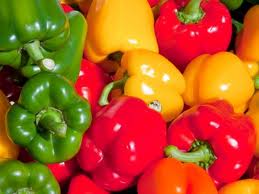I have another story about my mom. My family has a beach house, and all summer long, she has to cook for my dad, me, my husband, my sisters and their significant others, plus her two granddaughters. It is not easy, so she typically bought produce in bulk from Costco. This past summer, while grilling those cute little bell peppers, she noticed the wax on the conventional peppers melting off. Ew. After that, she declared that she was only buying organic.
Truthfully, both conventional and organic produce usually have some kind of wax, which prevents bruising and increases their shelf life. However, I was thrilled with my mom’s decision to go organic.
What does organic mean? According to the USDA, organic produce is not farmed with conventional pesticides, fertilizers made with synthetic ingredients or sewage sludge, bioengineering or ionizing radiation. Conventional farming may utilize these methods. There is also the issue of GMOs (genetically modified organisms), but I will save my discussion of that for another post. With respect to the wax, organically grown produce does not contain any petroleum-based or synthetic wax, which is used on conventional produce.
I try to buy organic and local when I can. However, organic produce is often more expensive and can be harder to find, especially in the winter when less fruits and vegetables are in season.
A great tip when it comes to buying organic produce is to consider the “Dirty Dozen” and the “Clean 15.”
The Dirty Dozen list contains fruits and vegetables that, when conventionally grown, tend to contain the most amount of pesticides. Therefore, if you can buy these items in the organic section, you should try to do so. The list was expanded last year and is now called the “Dirty Dozen Plus.” It includes the following: apples, celery, cherry tomatoes, cucumbers, grapes, hot peppers, imported nectarines, peaches, potatoes, spinach, strawberries, sweet bell peppers, kale/collard greens and summer squash.
The Clean 15 list includes produce that, when conventionally grown, tend to have less pesticide residue. So, if you cannot always buy organic due to cost or availability, then buy these items conventionally grown. The list includes: asparagus, avocados, cabbage, cantaloupe, sweet corn, eggplant, grapefruit, kiwi, mangos, mushrooms, onions, papaya, pineapple, frozen sweet peas and sweet potatoes.
If your supermarket does not advertise which produce is organic, you can always look at the produce code stickers. A 4 digit code starting with a 3 or 4 marks conventionally grown produce. A 5 digit code starting with a 9 marks organic produce.
I find that following these lists provides excellent guidance in selecting food with minimal pesticides. The waxy peppers that turned my mom off of conventional produce were sweet bell peppers, which is on the Dirty Dozen list, so I am glad that she switched. She plans to expand her garden this summer at the beach, and I don’t think we will be buying produce at Costco anymore.

It was an aha! moment when those perfect looking but likely genetically modified peppers turned black on the grill from seared wax. Next to them the little green peppers from my garden toasted up beautifully . I have learned something from Becky everyday since the day she was born. Keep up the great work on this blog!